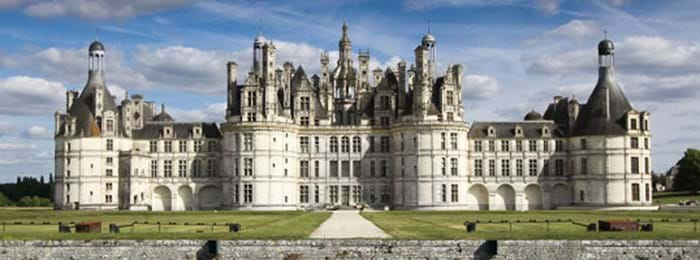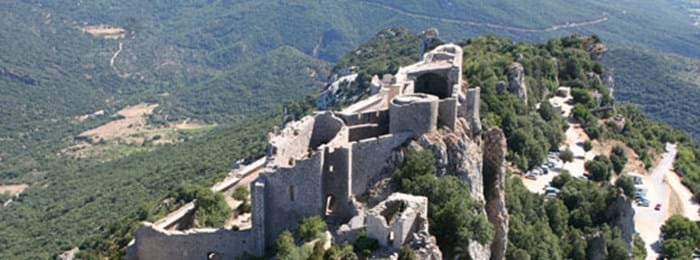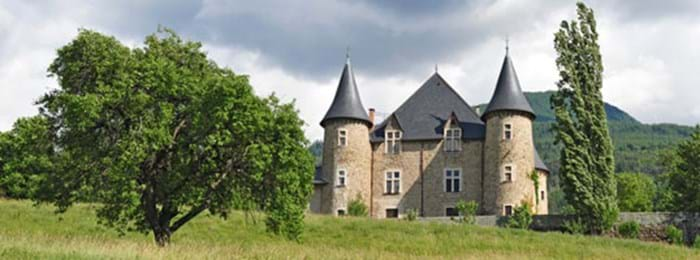From the towers of Chambord to the Cathar fortresses, the best of France's châteaux
It may be more than 200 years since the revolutionaries seized Paris and did away with 'les aristos', but the extraordinary architectural heritage of France's former ruling class is as evident as ever. France is littered with châteaux, each one a snapshot of history and often the only relic of the family for whom it was constructed. They're brick and stone monuments to a bygone age.
Although we typically translate the word château as 'castle', the word actually means something closer to 'manor house' - relatively few châteaux are fortified in the way we'd expect of an English castle. It's more helpful to think of them as stately homes - some, certainly, are built to withstand armies, but by and large they were the focal points of estates that operated under a miniaturised feudal system. Many châteaux, alas, were lost to either war or industrialism, but hundreds still remain; from mighty royal seats like the Palace of Versailles to the tiny manor houses, swathed in vines, that dot the Bordeaux countryside.
Châteaux de la Loire
Historically the summer retreat of choice for the kings of France and their great courtiers, the Loire valley contains some of the most outstanding examples of Renaissance architecture to be found anywhere in Europe.
Château Chambord

One of the biggest and most recognisable palaces in the world, Chambord was built as a hunting lodge for Francois I. Today it is owned by the state and receives hundreds of thousands of visitors each year - and for good reason. Its eccentric assemblage of towers was inspired by the skyline of Constantinople, and the combination of its High Renaissance façade and sheer size are incredibly striking.
Château de Sully-sur-Loire
Sully-sur-Loire is one of the few points where the Loire can be forded - a strategic advantage that has led to it being consistently fortified since the Roman occupancy. Consequently, the building that has guarded it for the last 500 years is a true castle or château fort, with enormous round towers soaring from the riverbank to dominate the crossing. It's open every day but Christmas Day, with various activities throughout the year and an international festival of classical music held each June.
Château de Blois
Located in the very centre of the city of Blois, parts of this royal residence date from the 12th century. The Château de Blois is particularly notable for its ornate interior decoration, with a number of gleaming state rooms carefully restored during the 1840s. Another famous visitor, Joan of Arc, was blessed at the Château before driving the English from Orléans in 1429.
This is only a small selection of the many beautiful châteaux de la Loire. If you plan to make a number of stops, consider investing in a Pass'Châteaux season ticket (available for various combinations of châteaux) to cut the cost of your visits.
Châteaux Cathares
There are fifteen or so Cathar castles, royal citadels built along the French border which was then the pre-Spanish kingdom of Aragon. Like our translation of the word 'château', the phrase 'Cathar castles' contains a misnomer - in this case 'castle' is entirely the right word, but 'Cathar' is rather more questionable. The châteaux forts were built in the wake of the Catholic church's crusade against the Cathars (Christian heretics whose theology challenged Rome); and whilst Cathars had certainly sheltered in the area, the fortified villages in which they hid were destroyed to make way for the castles.
Nevertheless, the now-ruined châteaux cathares are well worth a visit. Open to visitors, they are largely open-air and offer the opportunity to climb steep fortifications, gaze down towards Perpignan and the Spanish border and transport yourself back to the bloody border conflicts that raged through the region for centuries. For more information, visit the Pays Cathare tourism website.

Stay in a Château
Can't bear to go back to your hotel at the end of the day? No problem! Châteaux all over France have converted to offer (surprisingly reasonable) hotels and guest-houses, and even some are available to rent in their entirety. These are just a few of the options open to adventurous holidaymakers (or those who want to pretend they're royalty for a few days) - for a wider selection, try exploring http://www.bienvenueauchâteau.com/.
Château Ribagnac - Limousin
Run by a young family from London who moved to Limousin ten years ago, Château Ribagnac is a luxuriously appointed guest house set in 35 acres of grounds. Dating from around the 1600th century, it was used as a secret Resistance hospital during the Second World War, and now offers an exciting and child-friendly base for your holiday in central France. If you’re travelling with your family, don’t forget paints or sketchbooks - deers, wild boars and beech martens can all be spotted on the property. Click for more details
Château Picomtal - Hautes-Alpes
A true castle nestled in the historic peaks of the Hautes-Alpes region, Château Picomtal’s accommodation is comprised of nine luxurious suites available from April to November for bed and breakfast. Located at the entrance to the Ecrins national park, this is a perfect spot for those who wish to use a château as a base for mountain sports or other outdoor pursuits. Click for more details

Château de l'Oiselinière - Brittany
A medieval château at the heart of a vineyard, Château de l’Oiselinière was redesigned two hundred years ago in the style of a Tuscan villa. An ideal base for those interested in watersports, wine or simply whiling away the hours, this striking château offers a table d'hôte menu each evening as well as the usual breakfast. The perfect base from which to explore Brittany. Click for more details
Getting there and around
There are châteaux all over France, so where you travel is entirely up to you - but since most stately homes are in the countryside, you're probably going to need a car. Eurotunnel Le Shuttle takes just 35 minutes to whisk you from Folkestone to Calais, and from there you can head onto the autoroute in the direction of whichever castle, palace or manor has taken your fancy. And don't forget that the Nord-Pas-de-Calais region itself contains more than seventy beautiful châteaux! Whether you want to hire a stately home as a base for your holiday or travel from place to place, starting your trip with Eurotunnel Le Shuttle gives you the flexibility to truly immerse yourself in the world of France's best châteaux.
Book your journey